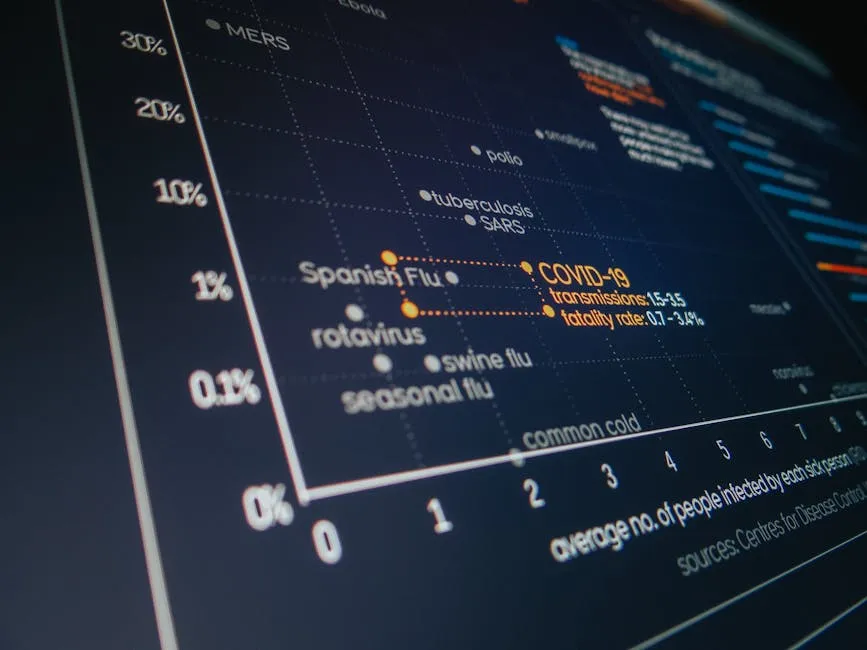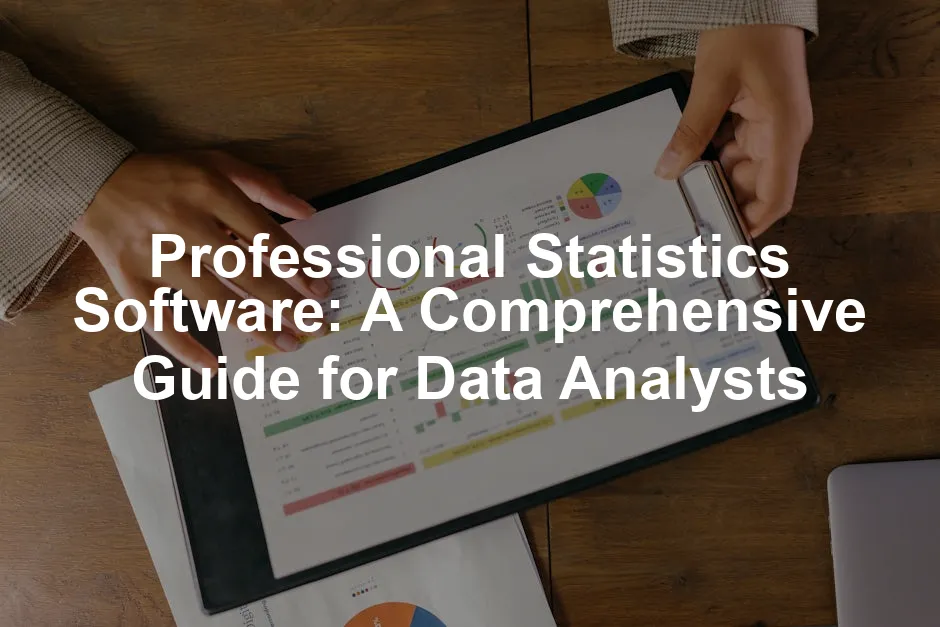Introduction
Professional statistics software is essential for data analysis. It enables users to perform complex calculations and visualize results efficiently. Researchers, data analysts, and students benefit greatly from these tools. In this article, you’ll learn about the different types of statistics software available. We’ll discuss key features and help you choose the right tool for your needs. But first, if you want to dive deep into R programming, consider grabbing R Programming for Data Science by Hadley Wickham. It’s a fantastic resource that will elevate your data analysis game!
Summary and Overview
Professional statistics software includes a range of tools designed for in-depth data analysis. These tools vary from open-source options to commercial software. The right choice depends on your specific analytical needs and budget. Choosing the right software is crucial. Each tool offers distinct features that cater to different analytical tasks. Professional software typically includes advanced statistical modeling, data visualization, and robust data management capabilities. For those who want to analyze data effectively with Python, check out Python for Data Analysis by Wes McKinney. It’s a must-read!Understanding Professional Statistics Software
Professional statistics software is designed for serious data analysis. It equips users with tools necessary for rigorous research and insightful conclusions. The differences between basic and professional software are significant. Basic tools may handle simple tasks, but professional software supports advanced analytics. If you’re curious about the essentials of SAS, consider SAS Essentials: Mastering SAS for Data Analytics to get you started. In academia, business, and healthcare, these tools play a vital role. They help users interpret complex data, ensuring informed decision-making. Statistics show that significant industries rely on professional statistical software. For instance, healthcare and finance often use these tools to analyze data effectively. When selecting software, consider your specific requirements. What analyses do you need to perform? Understanding your needs will guide you toward the best option. If you’re looking into data visualization, don’t miss Data Visualization: A Practical Introduction by Kieran Healy for great insights.
Types of Statistical Software
Open-source Software
Open-source software is a popular choice in the data analysis community. Tools like R and Python lead the pack. R excels in statistical computing and graphics. Python is versatile, with libraries like Pandas and NumPy for data manipulation. These tools are cost-effective as they are free to use. This accessibility allows individuals and organizations to conduct data analysis without hefty license fees. Cost savings can be significant, especially for startups or educational institutions. For a comprehensive guide on using R effectively, check out The Complete Guide to R Programming. Community support is another major benefit. Users can access forums, tutorials, and documentation shared by other enthusiasts. This collaborative environment fosters learning and problem-solving. You can often find resources tailored to specific statistical needs, making it easier to get started.Proprietary Software
Proprietary software includes well-known tools like SPSS, SAS, and Stata. These tools are designed for users who require advanced analytics. SPSS is user-friendly, ideal for social science research. SAS is robust, favored by large organizations for its powerful data handling capabilities. One key advantage of proprietary software is the advanced features available. These tools offer extensive statistical techniques and built-in modeling options. Users benefit from professional customer support, ensuring help is available when needed. If you’re interested in learning more about SPSS, SPSS Statistics for Data Analysis is a great option. Licensing and pricing structures vary. While some tools charge per user, others offer subscription models. This flexibility allows organizations to choose a pricing plan that fits their budget. However, initial costs can be high, which is worth considering.Freeware and Public Domain Software
Freeware includes tools like WinBUGS and GeoDA, which serve specific analytical purposes. These can be excellent for educational use or small projects. They often provide basic functionalities without cost, making them accessible to all. If you’re interested in spatial data analysis, consider GeoDA Software for Spatial Data Analysis. However, limitations exist. Freeware may lack advanced features found in paid software. Users might encounter restrictions on data size or analysis capabilities. Despite this, they can still perform standard statistical tasks effectively. For educational purposes, freeware can be particularly suitable. Students can gain practical experience without financial barriers. This exposure is valuable for building skills and understanding statistical concepts.
Key Features of Professional Statistics Software
User Interface and Usability
A user-friendly interface is crucial for effective data analysis. Beginners often find software overwhelming. Intuitive designs help users navigate functions easily. Learning curves differ between beginners and advanced users. Newcomers need straightforward tools, while experienced users may prefer customization options. Tailoring the interface enhances productivity for those familiar with the software. If you want to dive deeper into advanced R techniques, consider Advanced R by Hadley Wickham. Customization is vital for advanced users. They often need specific functionalities tailored to their workflows. Options to modify the layout or shortcuts can make a significant difference in efficiency.Data Management and Visualization
Efficient data handling is crucial in statistics. Good software allows you to import and export data effortlessly. This capability ensures that users can work with various file formats without hassle. Whether you’re pulling data from a CSV file or exporting results to Excel, these functions save time. Visual representation of data analysis results is equally important. Charts and graphs can make complex data easier to understand. They help communicate findings clearly to stakeholders. Many software options provide customizable visualizations, like histograms, scatter plots, and box plots. These tools enhance your ability to interpret and present data effectively. If you’re looking to create stunning visualizations, don’t forget to check out Tableau Desktop Professional Edition.
Statistical Analysis Techniques
Professional statistics software supports a variety of statistical methods. Understanding these methods is key for accurate analysis. Descriptive statistics summarize data through measures like mean, median, and mode. This helps provide an overview of your dataset. For a comprehensive guide on descriptive statistics, check this link. Inferential statistics, on the other hand, allow you to make predictions or generalizations about a population. Techniques such as hypothesis testing and confidence intervals fall within this category. Advanced techniques are becoming increasingly important. Machine learning integration is a game-changer in data analysis. This allows users to apply algorithms to discover patterns and insights. Software that supports both traditional and advanced methods can cater to a wider range of analytical needs. To learn more about machine learning, grab Machine Learning Yearning by Andrew Ng.
Choosing the Right Software for Your Needs
Assessing Your Requirements
When selecting statistical software, start by assessing your specific needs. Consider the types of projects you typically work on. What statistical methods do you require? Budget is another key factor. Some software can be expensive, while others are more affordable or even free. Make sure to evaluate the features you need against your budget constraints. If you’re looking for a comprehensive introduction, check out Data Science for Dummies.Popular Software Comparisons
Comparing popular software options is essential. Look at features, pricing, and usability. For instance, SPSS is known for its ease of use and extensive features. However, it may come with a higher price tag. For more information on SPSS, refer to this comprehensive guide. On the other hand, R is free and highly versatile, but it has a steeper learning curve. User reviews can provide insights into the strengths and weaknesses of each option. Gathering this information helps you make a more informed decision. If you’re considering Stata, check out Stata: The Basics for a solid foundation.
Case Studies: Successful Use of Statistical Software
Statistical software has significantly impacted research outcomes across various fields. For example, researchers at a leading university used SPSS to analyze survey data from thousands of respondents. This software helped them identify key trends in consumer behavior, leading to actionable insights for marketing strategies. The ease of data management allowed the team to focus on interpreting results instead of getting bogged down in complex calculations. In another instance, a healthcare institution utilized R for analyzing patient data. The software enabled them to conduct survival analysis, revealing critical information about treatment effectiveness. This analysis ultimately enhanced patient care protocols and improved outcomes. The integration of advanced statistical methods streamlined their research processes and ensured accuracy in reporting. Moreover, using MATLAB, engineers at a tech firm modeled extensive datasets from experiments. The software’s powerful visualization tools clarified complex relationships within the data. This clarity facilitated better decision-making and optimized product development timelines. If you’re an engineer, consider MATLAB for Engineers for your projects.
Future Trends in Statistical Software
The landscape of statistical software is evolving rapidly, driven by technological advancements. One significant trend is the integration of AI and machine learning. These technologies enhance data analysis capabilities, allowing users to uncover patterns and make predictions more accurately. Software that incorporates AI can learn from data, improving its analytical power over time. Another emerging trend is the shift towards cloud-based solutions. These platforms enable collaborative work, allowing teams to access and analyze data from anywhere. Such flexibility is crucial for remote research and data analysis, particularly in an increasingly digital world. Cloud solutions also often come with built-in tools for data visualization and sharing, simplifying the communication of results. If you’re interested in cloud-based data tools, check out Google Data Studio. As these trends continue to shape the future of statistical software, users can expect even more powerful, user-friendly tools that transform how they analyze data. Staying informed about these advancements will help researchers and analysts choose the best software for their needs.
Conclusion
In this article, we explored the importance of professional statistics software. We discussed its significant impact on research outcomes and highlighted future trends shaping the industry. Choosing the right statistical software is essential for effective data analysis. By considering your specific needs, you can find the best tools to support your work. Explore various options and resources to maximize the utility of your data analysis efforts. The right software can transform your approach, making your research more efficient and insightful. If you’re passionate about data science, don’t forget to check out The Data Science Handbook for comprehensive insights.FAQs
What is the best statistical software for beginners?
If you’re just starting, user-friendly options like SPSS and JMP are excellent choices. SPSS offers a drag-and-drop interface, making it easy to manage data and perform analyses. JMP also provides an intuitive design, perfect for visualizing data. Both tools come with extensive tutorials, helping beginners learn quickly.
Can I use free statistical software for professional work?
Absolutely! Open-source tools like R are powerful and versatile enough for professional use. R supports a wide range of statistical methods and data visualization techniques. Many companies and researchers rely on it for complex analyses. Plus, it has a strong community, providing resources and support.
What features should I look for in statistical software?
Key features to consider include data visualization capabilities and statistical techniques. Look for software that allows you to create clear graphs and charts. Additionally, ensure it supports essential statistical methods like regression and ANOVA. User-friendly interfaces and good documentation are also important for ease of use.
Is statistical software necessary for data analysis?
Using statistical software can significantly enhance your data analysis process. It improves efficiency and accuracy, especially with large datasets. These tools automate complex calculations, reducing human error. They also provide visualizations that help communicate results clearly, making them invaluable for researchers.
How often should I upgrade my statistical software?
Regular upgrades are essential to stay current with technological advancements. New features and improvements often enhance functionality and security. Check for updates at least once a year, or whenever a new version is released. Staying updated ensures you have access to the latest tools and capabilities.
Can statistical software integrate with other tools?
Many statistical software programs offer integration with programming languages like Python and R. This capability allows users to extend functionalities and automate workflows. Additionally, integration with tools like Excel can enhance data management, making the analysis process more seamless.
All images from Pexels




